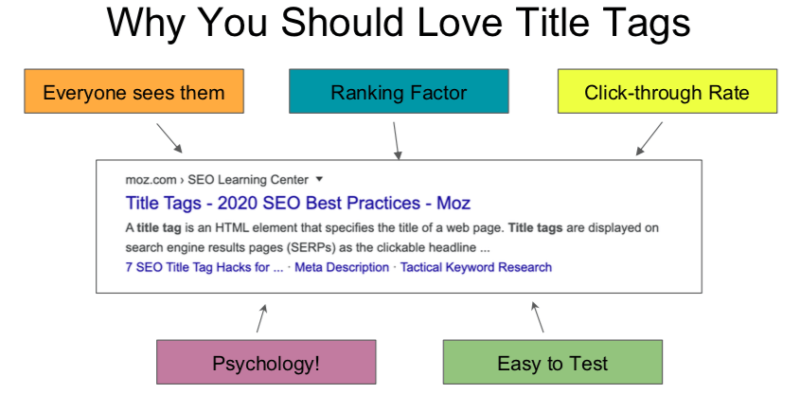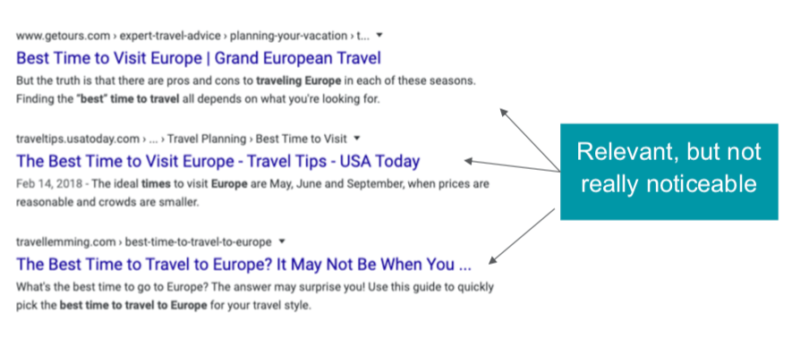
How to Write Compelling Title Tags.
Moz’ Cyrus Shepard offers top tips on boosting CTRs and earning more traffic with advanced tactics for SEO title tag optimisation. In this posting, he outlines, not only the benefits of the title tag but also ‘going beyond the basics’ and how to improve them. Here’s a summary of the post, the complete article can be viewed by clicking on this link.
Why are title tags important?
Title tags are the clickable headline that shows up on the SERP. Dictated by an HTML element that reflects the title of a web page, these tags are designed to help search engines understand the content of the page. There are key reasons why title tags are important, Shepard emphasized.
It’s the first thing someone sees when conducting a search. “People may ignore your content, they may skim over it, they may ignore your meta description, your bread crumbs. But everybody, when they do a Google search, sees your title tag as the number one decision,” Shepard said.
Title tags are a ranking factor. Shepard explained that Mos has been “studying the correlation of title tag signals to rankings over the years,” and despite a slowdown in correlations, title tags still influence click-through rate. “No matter what you do, the title tag more than any other element that displays in the SERPs influences whether or not people are going to click your result.”
A mix of science and psychology. Even if a title tag doesn’t help you rank, it can still be a critical touchpoint to entice people into clicking. With the right language and messaging, title tags can play into a searcher’s curiosity and answer the question
Title tags are easy to test. “You can change your title tag, go to Google Search Console, recrawl, reindex the URL, and see the changes in Google search results, sometimes within minutes,” Shepard said. From there, SEOs can examine the performance over the next few days to it had an effect. “And also, if things don’t work out, you can easily change your title tag back,” he added.

How to write compelling title Tags
Shepard uses the acronym NPR to help guide the thought process behind writing compelling headlines:
N = Noticeable
P = Promising
R = Relevant
Noticeable.
In the below example of a Google search result for the best time to visit Europe, the title tags essentially all say the same thing. “I have to admit they’re a little uninspiring,” Shepard said. “There is nothing noticeable about these results. They’re just using the keyword but there’s nothing enticing me to click. There’s nothing to differentiate one of these results from any other result.”
Promising.
“When a title is promising, it tells you what you should expect when you click. It goes beyond the keyword to promise you something to satisfy an emotional need. And good titles typically offer this,” Shepard explained.
When writing title tags, SEOs should think about how to use promising language to satisfy those needs as people search. He offers six ways to make title tags more promising for searchers:
> Surprise them
> Thrill them
> Impress them
> Educate them
> Reassure them
> Help them
“Even if you’re selling, you know, blenders. You can try to surprise people, thrill them, and impress them. They’re not just looking for blenders. They want something extra. Give them that in the title and you can entice the click. It’s hard to do, but you can do it,” Shepard said.
Relevancy.
Without relevancy, the elements of ‘noticeable’ and ‘promising’ can be easily diluted. Searchers are looking for results that are relevant to their intent, Shepard explained.

In the above example, he demonstrates the difference between a relevant and non-relevant title tag for a search related to Target coupons. “The second result was a Target ads manufacturer. That’s not what I’m looking for. That’s not the promise that I want. I want the target promo codes and coupons,” he added.







